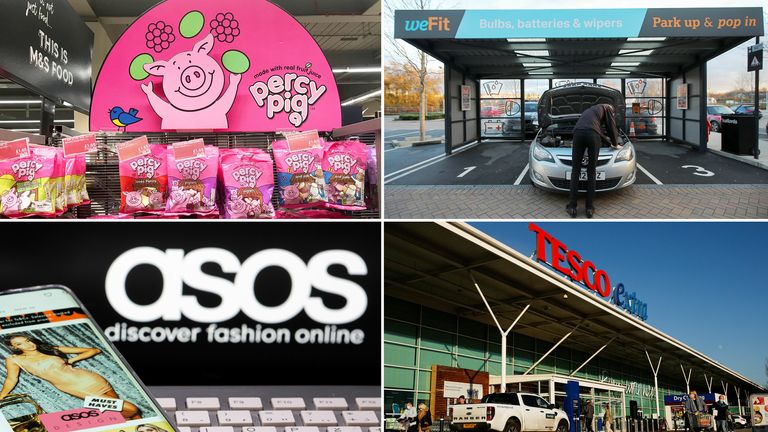The much-vaunted turnaround at Asos may take longer to deliver than expected.
That is the main conclusion to be drawn from the results and trading statement published on Wednesday by the online fast-fashion specialist.
Jose Antonio Ramos Calamonte, who joined Asos in January 2021 as chief commercial officer following an 18-year career in retail that included stints at Zara's parent company Inditex and Carrefour, became chief executive in June last year following a period during which it had gone without a permanent CEO for eight months.
Four months later, he unveiled a turnaround plan, promising to "strengthen Asos over the next 12 months".
Unfortunately, that may have created the impression among some investors that a turnaround could be executed relatively quickly, not least because Asos has been talking about "refreshing its strategic priorities" since as long ago as November 2021.
Asos shares fell by nearly 19% today, wiping out all of the gains the price has made this year, as the red ink continued to flow liberally across the accounts.
A pre-tax loss of £290.9m for the six months to the end of February was up from one of just £15.8m for the same period a year earlier.
Sales for the period were down 8% to £1.84bn. Net debt jumped from £62.6m to £431.7m. And there was a free cash outflow during the period of £262.7m.
One had to look closely at the statement to find evidence of much going right.
The number of active customers fell by 7%, to 24.9 million, while the number of total orders shipped fell by 14% to 43.2 million. On the plus side, customers who stuck with Asos during the period are placing orders slightly more frequently, as well as spending more.
According to the company, though, some of the setbacks were due to deliberate actions to improve profitability.
Part of the decline in sales were put down by Asos to the cost of living crisis and its impact on the ability of consumers to spend. But it was also due to the company ordering less stock for the spring and summer of this year, raising prices in some countries and seeking to reduce markdowns where possible.
As part of this, there has also been a weeding-out of some 35 brands previously sold on the platform which were unprofitable.
All in all, taking those factors into account, the statement gives the impression that Asos may not be too unhappy about losing some of the active customers it previously had.
And, Asos suggests, the measures it is taking are starting to pay off. Its gross margin in March and April was some 300 basis points (3%) better than in those months last year. That will represent meaningful progress if it can be maintained.
As for the increase in headline losses, there are reasons for those too, quite apart from the reverse in sales. They take into account a number of one-off hits including a stock write-off that came to £128.2m and impairments to property values worth some £49.4m. Many of these measures were telegraphed earlier in the year by Mr Ramos Calamonte as part of a big cost-cutting push involving the closure of some office space and storage facilities as well as job cuts. Other one-off factors, such as the postal strikes in the UK, have also hurt.
The good news is that Asos claims to be winning market share among the demographic groups it targets, chiefly 16-35-year-old shoppers.
Mr Ramos Calamonte could also point to a solid performance from the Topshop brand, acquired in February 2021 from the administrator of Sir Philip Green's Arcadia empire, whose sales grew by 12% year on year.
But this is a tough time to be trying to execute a turnaround. The squeeze on disposable incomes in all the territories where Asos trades - the UK, Europe and the United States - may be starting to abate, but it is still keenly felt.
Established high street names - competition from which was absent in the lockdown periods during which Asos thrived - are fighting hard for custom and, as shown by recent trading updates from the likes of Inditex, Next and Marks & Spencer, more than holding their own.
And they are the least of Mr Ramos Calamonte's worries so far as the competition goes. Shein, the Chinese fast-fashion business valued at around $100bn, is gunning for Asos. It already reckons to account for half the fast-fashion sales in the United States and, despite polls suggesting Gen Z consumers are more fixated on ethical issues than their predecessors, there is little evidence for many of them being motivated by anything other than price when they shop for clothes. That plays to Shein's strengths and its ability to stock a wider supply of ranges than even Inditex, let alone Asos, can manage.
Read more business news:
Wetherspoon's heading for record profits despite slow coronation
'Alarming' new lorry laws could cost lives, campaigners argue
Some analysts argue that a lot of the bad news had already been signalled.
John Stevenson, retail analyst at the investment bank Peel Hunt, told clients that today's results were "very much as bad as expected".
In the meantime, some followers fret that a new share issue may be in the offing given the expansion in net debt, although the company was keen to play down those concerns today.
It does, however, help explain today's dramatic share price reverse.
That weakness does not mean Mr Ramos Calamonte is not doing the right thing. His switching of focus from sales growth at any cost, to more profitable growth, is probably long overdue.
Sceptics, though, will require more proof that the progress being made is lasting.
Asos turnaround pace frustrates fast-fashion firm's investors - Sky News
Read More


No comments:
Post a Comment